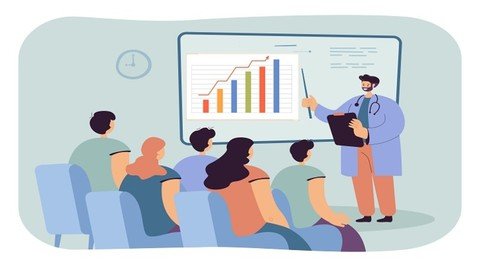Statistics For Healthcare Professionals

Last updated 5/2021
MP4 | Video: h264, 1280x720 | Audio: AAC, 44.1 KHz
Language: English | Size: 1.22 GB | Duration: 3h 50m
A step by step course to understand the logic of medical statistics and master data analysis using SPSS and Jamovi softw
What you'll learn
Understanding the basic concepts of statistics without needing to learn complex equations. Learn how to analyse your research data with SPSS. and Jamovi
Requirements
The course does not require any previous experience in statistical analysis
the student will need his own licensed copy of SPSS. If you don't currently have one, you can download a trial version on the IBM website
If the learner decided to use Jamovi he can download the program for free from Jamovi website
Description
During my beginnings in medical school, I had to understand the concept of statistics in order to complete my Master and MD thesis but I had to work with many books and software in order to learn how to apply the appropriate statistical tests for my research. After finishing my MD, I decided to earn master's degree in biomedical from the University of Newcastle. Although it is interesting, I have to understand a lot of formulas to get into the logic of statistical theory. After finishing my study, I dedicated my time to teach statistics to medical students in a way that they can understand the basics without getting in details of mathematical equations. If you are starting a research work related to health sciences and you find in statistics a difficult obstacle to jump, this is your course, which I have developed in a practical way with visual illustration.Lessons outcomeBy the end of this course, the students will be able to understandHow to describe the dataRelative risk and odds ratioThe difference between standard error and standard deviationWhy the confidence interval is really importantHow to choose the statistical test How to conduct common statistical tests such as Paired and unpaired t test Mann Whitney U tets ANOVA Chi squareAll examples mentioned in the course represent research questions and study designs that are frequently used in medical literature. Moreover, the course does not require any previous experience in statistical analysis, it will take the student step by step to understand basic terminologies that are frequently used in data analysis. Visual illustrations help the student to understand the output of statistical software without getting into the detail of statistical equationStatistical software used in this courseThe focus of current training program will be to help participants learn statistical skills through exploring SPSS and JAMOVI. The focus will be to develop practical skills of analyzing data, developing an independent capacity to accurately decide what statistical tests will be appropriate with a particular kind of research objective. The learner will have the ability to choose to run all statistical analysis using either SPSS and/or Jamovi. All statistical analysis will be demonstrated via 13 exercises using two types of statistical software. SPSSJamoviWho this course is for:Any healthcare professionals looking to understand basics of statistics Faculty member looking to master SPSS and advance their data analysis required for conduction of medical researchFaculty member looking to master Jamovi and advance their data analysis required for conduction of medical research
Overview
Section 1: How to navigate the course
Lecture 1 Welcome
Section 2: How to describe your data
Lecture 2 Descriptive statistics
Lecture 3 Introduction to SPSS
Lecture 4 Introduction to Jamovi
Lecture 5 SPSS exercise 2
Lecture 6 Jamovi exercise 2
Section 3: Contingency table, relative risk, odds ratio
Lecture 7 Contingency table
Lecture 8 Relative risk and odds ratio
Lecture 9 SPSS exercise 3
Lecture 10 Jamovi exercise 3
Section 4: Confidence interval
Lecture 11 Confidence interval
Lecture 12 SPSS exercise 4
Lecture 13 Jamovi exercise 4
Section 5: Hypothesis testing
Lecture 14 Hypothesis testing
Section 6: How to choose statistical analysis
Lecture 15 How to choose statistical test
Section 7: Analysis of two paired groups
Lecture 16 Logic of paired T test
Lecture 17 SPSS exercise 5
Lecture 18 Jamovi exercise 5
Lecture 19 Logic of Wilcoxon U test
Lecture 20 SPSS exercise 6
Lecture 21 Jamovi exercise 6
Section 8: Analysis of two unpaired groups
Lecture 22 Logic of unpaired T test
Lecture 23 SPSS exercise 7 & 8
Lecture 24 Jamovi 7 & 8
Lecture 25 Logic of Mann U test test
Lecture 26 SPSS exercise 9
Lecture 27 Jamovi exercise 9
Section 9: Analysis of three groups
Lecture 28 Logic of ANOVA
Lecture 29 SPSS exercise 10
Lecture 30 Jamovi exercise 10
Lecture 31 Logic of kruskal wallis test
Lecture 32 SPSS exercise 11
Lecture 33 JAMOVI exercise 11
Section 10: Chi square
Lecture 34 Logic of chi square
Lecture 35 SPSS exercise 12
Lecture 36 Jamovi exercise 12
All healthcare professionals including physicians nurses, and pharmacists
Homepage
https://www.udemy.com/course/statistics-for-healthcare-professionals/Fikper
wblrl.Statistics.For.Healthcare.Professionals.part1.rar.html
wblrl.Statistics.For.Healthcare.Professionals.part2.rar.html
Rapidgator
DOWNLOAD FROM RAPIDGATOR.NET
DOWNLOAD FROM RAPIDGATOR.NET
Uploadgig
DOWNLOAD FROM UPLOADGIG.COM
DOWNLOAD FROM UPLOADGIG.COM
NitroFlare
DOWNLOAD FROM NITROFLARE.COM
DOWNLOAD FROM NITROFLARE.COM
Please Help Me Click Connect Icon Below Here and Share News to Social Network | Thanks you !
In today's era of digital learning, access to high-quality educational resources has become more accessible than ever, with a plethora of platforms offering free download video courses in various disciplines. One of the most sought-after categories among learners is the skillshar free video editing course, which provides aspiring creators with the tools and techniques needed to master the art of video production. These courses cover everything from basic editing principles to advanced techniques, empowering individuals to unleash their creativity and produce professional-quality content.


Comments (0)
Users of Guests are not allowed to comment this publication.